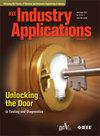零偏心附近提高MPPT效率的升压/降压部分功率变换器混合调制方法
IF 4.2
2区 工程技术
Q2 ENGINEERING, ELECTRICAL & ELECTRONIC
引用次数: 0
摘要
升压/降压部分功率转换器(PPCs)提供更低的偏心和更高的效率,正如文献所证明的那样。然而,如果变换器保持相同的调制技术,它们的工作接近零偏心,即具有相同的源和负载电压,是具有挑战性的。这是因为当PPC在零串联端口电压下工作时,电容器没有足够的能量来提供所需的电压增益。由于使用传统调制,这使得升压/降压PPC不适合在光伏(PV)应用中实际使用。在接近零的偏心操作下,最大功率点跟踪(MPPT)效率在串联端口的零电压附近下降。本文提出了一种混合调制MPPT方法,使PPC在零偏系数附近平稳运行,提高了MPPT效率。所提出的混合调制利用反向功率流,即循环能量,向电感器充电,使电流可控性接近零偏心。然而,由于提供了更高的效率,PPC在低偏袒区域之外使用PSM。实验研究证实了该方法的有效性。连接到350v直流母线的2.5 kW PPC原型在工作象限之间的转换期间显示出99.56%的MPPT效率。本文还将所提出的方法与现有的一些方法进行了比较,以证明其优越性。本文章由计算机程序翻译,如有差异,请以英文原文为准。
A Hybrid Modulation Approach for Step-Up/Down Partial Power Converter With Improved MPPT Efficiency Around Zero Partiality
Step-up/down partial power converters (PPCs) offer lower partiality and increased efficiency, as evidenced by the literature. However, their operation near zero partiality, i.e., with the same source and load voltage, is challenging if the converter maintains the same modulation technique. This is because the capacitor does not have enough energy to provide the required voltage gain when a PPC operates at zero series port voltage. This renders a step-up/down PPC unsuitable for practical use in photovoltaic (PV) applications, resulting from using a conventional modulation. At near-zero partiality operation, the maximum power point tracking (MPPT) efficiency drops around zero voltage in the series port. The paper proposes a hybrid modulation MPPT method that allows PPC to operate smoothly near zero partiality coefficient, enhancing MPPT efficiency. The proposed hybrid modulation utilizes a reverse power flow, i.e., the circulating energy, to charge the inductor with energy, enabling current controllability near zero partiality. However, PPC employs PSM outside the low partiality region due to the higher efficiency provided. Experiment studies confirm the effectiveness of the proposed approach. A 2.5 kW PPC prototype connected to a 350 V dc bus demonstrates MPPT efficiency of 99.56% during transitions between operating quadrants. A comparative assessment of the proposed approach with some existing methods is also carried out to justify its superiority.
求助全文
通过发布文献求助,成功后即可免费获取论文全文。
去求助
来源期刊

IEEE Transactions on Industry Applications
工程技术-工程:电子与电气
CiteScore
9.90
自引率
9.10%
发文量
747
审稿时长
3.3 months
期刊介绍:
The scope of the IEEE Transactions on Industry Applications includes all scope items of the IEEE Industry Applications Society, that is, the advancement of the theory and practice of electrical and electronic engineering in the development, design, manufacture, and application of electrical systems, apparatus, devices, and controls to the processes and equipment of industry and commerce; the promotion of safe, reliable, and economic installations; industry leadership in energy conservation and environmental, health, and safety issues; the creation of voluntary engineering standards and recommended practices; and the professional development of its membership.
 求助内容:
求助内容: 应助结果提醒方式:
应助结果提醒方式:


